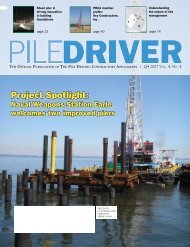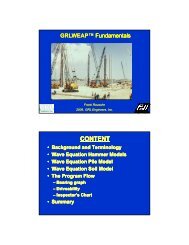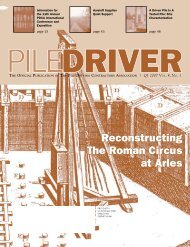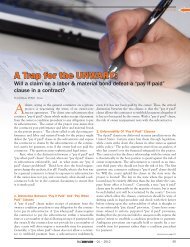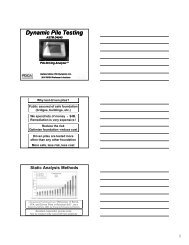Downloads - Pile Driving Contractors Association
Downloads - Pile Driving Contractors Association
Downloads - Pile Driving Contractors Association
You also want an ePaper? Increase the reach of your titles
YUMPU automatically turns print PDFs into web optimized ePapers that Google loves.
nomena of drag load and downdrag in respect to the structural<br />
and geotechnical axial performance of piles.<br />
Negative skin friction – Shaft resistance mobilized as the soil<br />
moves downward relative to the pile. Observations from longterm<br />
field monitoring support that negative skin friction develops<br />
in essentially all piles.<br />
Drag load – The axial compressive load induced on the pile<br />
element due to accumulated negative skin friction when the soil<br />
tends to move downward relative to the pile.<br />
Neutral plane – The location along the pile at which the sustained<br />
forces (i.e., drag load plus sustained structure load) are in<br />
equilibrium with the combination of (positive direction) shaft<br />
resistance (below the neutral plane) and toe resistance. This<br />
depth is also where there is zero relative movement between the<br />
pile and soil.<br />
Downdrag – The downward movement of the pile due to<br />
settlement of the surrounding ground. The downdrag magnitude<br />
is equal to the settlement of the soil at the location of the<br />
neutral plane.<br />
Geotechnical axial capacity – The combined shaft and toe<br />
resistances where the pile will no longer reach static equilibrium<br />
and will experience continued downward movement. Positive<br />
shaft resistance occurs along the full length of the pile and drag<br />
load is eliminated.<br />
Factor of safety on geotechnical capacity – The ratio between<br />
the geotechnical axial capacity divided by the sum of dead load<br />
plus live load, drag load is not included.<br />
Structural axial strength – The compressive axial strength of<br />
the pile section affected by dead load plus drag load.<br />
Factor of safety on structural strength at the neutral plane – The<br />
ratio between the structural axial strength at the neutral plane<br />
divided by the sum of dead load plus drag load, live load is not<br />
included.<br />
Although the issue of design of pile foundations is rather<br />
broad, this note will address the special condition of consequence<br />
for a piled foundation in liquefying soil during a seismic<br />
event.<br />
Axial <strong>Pile</strong> Design for Liquefied Conditions and AASHTO<br />
Sandy soil layers may undergo compression during liquefaction<br />
(Tokimatsu and Seed 1987; Ishihara and Yoshimine<br />
1992). This compression results in a downward movement of<br />
the overlying soil layers. For piled foundations, the movement<br />
may influence the distribution of the axial load distribution in<br />
the pile, notably the magnitude of the drag load and the location<br />
of the force equilibrium in the pile — i.e., the neutral<br />
plane. Depending on the site conditions, the computed change<br />
in axial load resulting from liquefaction-induced settlement can<br />
have a significant impact on the pile design and foundation<br />
costs for projects in seismically active regions. Liquefaction is<br />
addressed in a few recently published design manuals, such as<br />
the AASHTO LRFD Bridge Design Specifications (2004, 2006)<br />
and AASHTO based state highway documents (e.g., MoDOT<br />
2005; WSDOT 2006). The AASHTO Specifications recommend<br />
adding the factored drag load from the soil layers above<br />
the liquefying layer to the factored dead and live loads from the<br />
structure and requires the factored shaft resistance in the soil<br />
layers below the liquefying layer plus the factored toe resistance<br />
to be equal or larger than the combination of the mentioned<br />
factored loads. However, the AASHTO Specifications do not<br />
recognize that a drag load is typically present in the pile prior to<br />
the earthquake (Fellenius 2006) and that, if the load applied to<br />
the pile would cause it to move downward relative to the soil,<br />
the drag load is eliminated. Nor do the Specs recognize that<br />
live load (transient load) and drag load cannot occur simultaneously.<br />
In the authors’ opinion, the AASHTO Specifications<br />
(2004) concept of designing for drag load is fundamentally<br />
flawed. Indeed, the treatment of liquefaction-induced drag load<br />
on piles, as presented in the AASHTO Specifications, can have<br />
a substantial ramification on foundation costs.<br />
SUB-SUBHEAD: Example<br />
In an effort to demonstrate the phenomena of drag load and<br />
downdrag in liquefiable soil, the effect of liquefaction-induced<br />
compression is considered for a site in northern California<br />
described by Knutson and Siegel (2006). The site is located<br />
approximately 70 km southeast of downtown San Francisco in<br />
Milpitas, California, and is underlain by Quaternary alluviual<br />
deposits (Division of Mines 1951). The upper soil conditions<br />
consist of interbedded clays and sands and are represented by the<br />
CPT data presented in Fig. 1. Potentially liquefiable layers are<br />
indicated in the figure. The liquefaction potential was evaluated<br />
for a M 7.8 earthquake and a horizontal ground acceleration<br />
of 0.6g using CPT data and the method presented by Robertson<br />
and Wride (1998) combined with the recommendations presented<br />
by Youd et al. (2000).<br />
The effects of drag load are assessed for 460 mm diameter<br />
piles installed to a depth of 30 m with a geotechnical capacity<br />
of 3,000 kN (obtained from static loading test) and an unfactored<br />
sustained axial load of 1,100 kN. According to the AASHTO<br />
Specifications (2004, 2006), in the absence of an earthquake,<br />
the design is not required to consider negative skin friction<br />
and drag load. In reality, negative skin friction will develop<br />
also under static conditions and accumulate to a drag load of<br />
about 900 kN at a neutral plane located at depth of about 13 m.<br />
The load and resistance distribution curves for static conditions<br />
are shown in Fig. 2. These curves are calculated applying recommendations<br />
of O’Neill and Reese (1999) and values of N60<br />
and undrained shear strength from correlations with CPT cone<br />
resistance. For this case, the curves are also approximately equal<br />
to values calculated using the Eslami-Fellenius CPT method<br />
(Eslami and Fellenius 1997).<br />
The curves shown in Fig. 2 can only be determined using<br />
unfactored values, as factored values will distort the magnitude<br />
of the maximum axial compressive load in the pile and the<br />
location of the neutral plane. The 3,000 kN capacity and the<br />
1,100 kN unfactored sustained load represent a factor of safety of<br />
2.7. The addition of the transient load of 400 kN would reduce<br />
the factor of safety to 2.0, and reverse the direction of the shaft<br />
resistance (from negative to positive) in the upper portion of the<br />
pile, but it would have no influence on pile settlement or the<br />
maximum compressive load in the pile at the neutral plane.<br />
Design of a pile foundation for downdrag cannot appropriately<br />
be considered in the context of geotechnical axial capacity,<br />
as it is a settlement issue. At the neutral plane, the soil and the<br />
pile move equally. Therefore, the magnitude of the settlement<br />
of the soil at the neutral plane is also the settlement of the pile<br />
— also known as downdrag. The proper design approach is to<br />
• Q4 • 2008<br />
69






